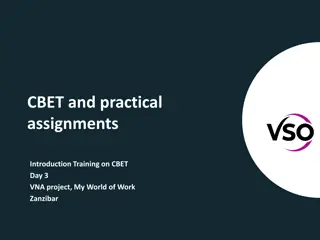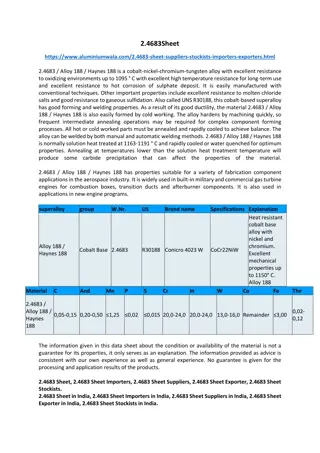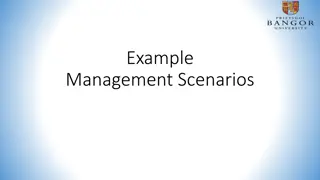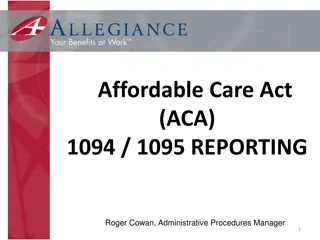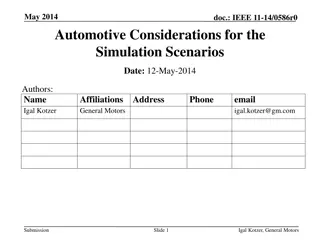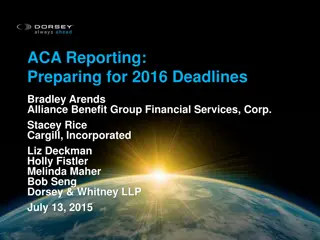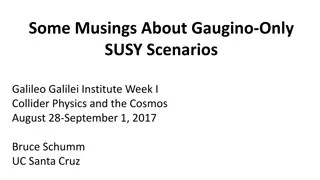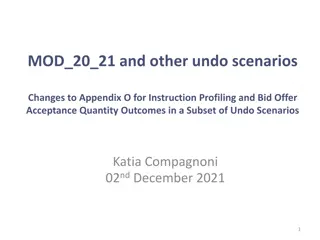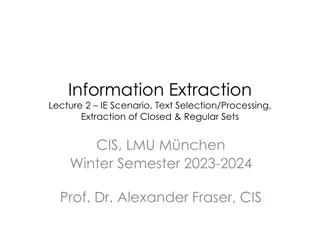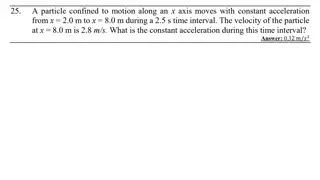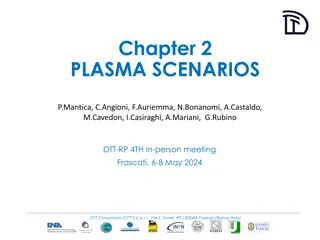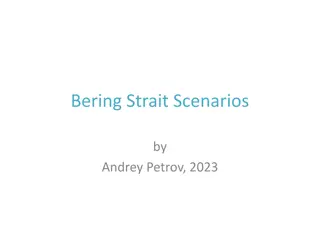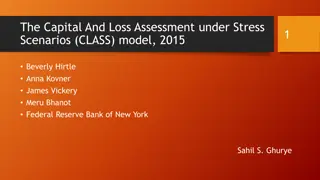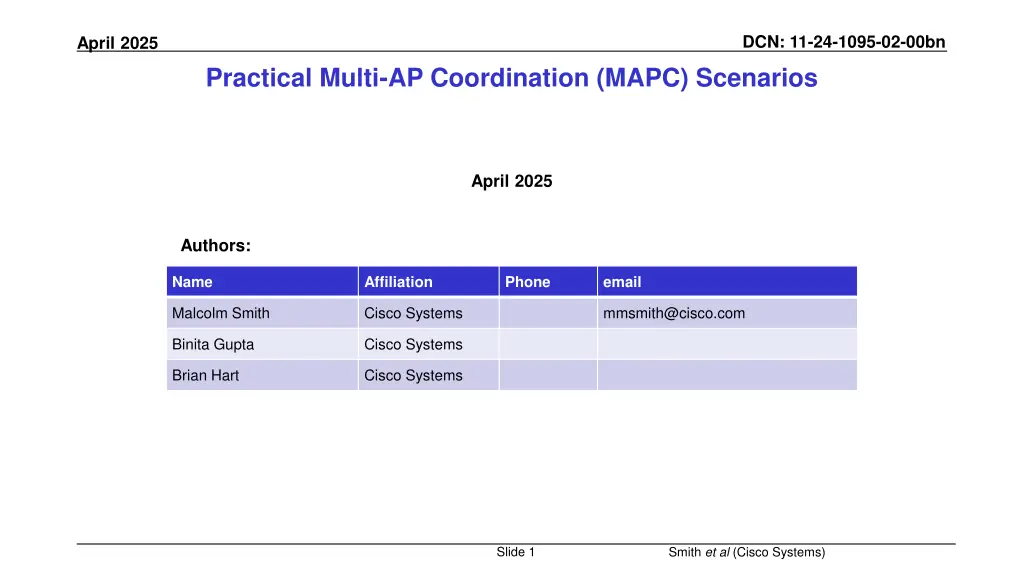
Practical Multi-AP Coordination Scenarios 2025
Explore key traffic profiles and QoS methods for managing delay congestion in wireless networks to ensure low-latency access for various services like multimedia, IIOT, XR, and more. Dive into the complexities of Wireless Time-Sensitive Networking (WTSN) and devise strategies for efficient multi-AP coordination. Authors from Cisco Systems present insights for optimized network performance in April 2025.
Download Presentation

Please find below an Image/Link to download the presentation.
The content on the website is provided AS IS for your information and personal use only. It may not be sold, licensed, or shared on other websites without obtaining consent from the author. If you encounter any issues during the download, it is possible that the publisher has removed the file from their server.
You are allowed to download the files provided on this website for personal or commercial use, subject to the condition that they are used lawfully. All files are the property of their respective owners.
The content on the website is provided AS IS for your information and personal use only. It may not be sold, licensed, or shared on other websites without obtaining consent from the author.
E N D
Presentation Transcript
DCN: 11-24-1095-02-00bn April 2025 Practical Multi-AP Coordination (MAPC) Scenarios April 2025 Authors: Name Affiliation Phone email Malcolm Smith Cisco Systems mmsmith@cisco.com Binita Gupta Cisco Systems Brian Hart Cisco Systems Slide 1 Smith et al (Cisco Systems)
DCN: 11-24-1095-02-00bn April 2025 Problem Statement Multi-service network that simultaneously supports: Low-latency channel access for multi-media, IIOT/XR, etc (~10ms) Ultra-reliable/ultra-low latency channel access for XR/IIOT* in Wireless Time-Sensitive Networking (WTSN) (~1ms)** Devices subject to irregular in-device coexistence (IDC) challenges Devices with P2P traffic Managed contention/congestion from OBSS With optimizations within the same MANAGED administrative domain (e.g. TUA-O, R-TWT, MLO***) With limited control over other UNAMNAGED administrative domains (e.g. QoS) With: High system efficiency Implementation simplicity Acceptable fairness with legacy generations *Industrial IOT (IIOT), AR/VR/MR/eXtended Reality (XR) ** Triggered Uplink Access Optimization (TUA-O), Restricted Target Wake Time (R-TWT), Multi-Link-Operation (MLO) Slide 2 Smith et al (Cisco Systems)
DCN: 11-24-1095-02-00bn April 2025 Key Traffic profiles Wireless TSN (WTSN) e.g. IIOT, XR STA traffic synchronized to WLAN via 802.11 or 802.1 means e.g. 802.1Qbv/AS** Rigid SCS QC parameters (SST, SI, etc)* Target: 1ms 99.9% (at least) Interactive real-time e.g. XR, 4K video conferencing STA traffic can be synchronized to WLAN via 802.11 means e.g. SCS QC, R-TWT Flexible SCS QC parameters (SST, SI, etc)* Target: 1-10ms 99.9% (at least) Collaboration/video-streaming STA traffic periodic but unsynchronized to WLAN Target 10-50ms 99.9% (at least) Non-real-time (background) aperiodic and unsynchronized *SCS QoS Characteristics (SCS-QC), Service Start Time (SST), Service/Scheduling Interval (SI) ** 802.1AS and 802.1Qbv applied to Wireless TSN (WTSN) see: https://avnu.org/wireless/ for example usage Slide 3 Smith et al (Cisco Systems)
DCN: 11-24-1095-02-00bn April 2025 QoS methods to manage delay congestion (My and OBSS) QoS Apply VI/VO WMM/EDCA parameters to specific flows Available in Managed, SP and Enterprise WLANs Triggered Uplink Access Optimization (TUA-O) Combined with SCS QoS Characteristics (QC) SI, delay bound, etc. Expected availability in managed, SP and Enterprise WLANs STA requests via SCS QC and AP aligns traffic with MU trigger with e.g. R-TWT/SCS QC SST* MLO enhanced Multi-Link-Single-Radio (eMLSR) expected to be commonly available in most WLANs Delay optimized mode assumed (i.e. first non-Busy link wins) Restricted TWT (R-TWT) Mapped to 802.1Qbv gates (i.e. time-slot reservation) for Wireless TSN (WTSN) applications Expected to be supported by a limited device set but not universally honored (e.g. legacy) Multi AP Coordination (MAPC) e.g. CoRTWT/CoTDMA/etc Under consideration by 802.11bn Details provided as needed here-in *Service Start Time (SST) can be explicitly requested via SCS QC to align with an existing TWT/R-TWT session or via the latter during SP establishment Slide 4 Smith et al (Cisco Systems)
DCN: 11-24-1095-02-00bn April 2025 BSS Coordination model Managed WLAN QOS (WMM) [assumed default] Wi-Fi 7 (TUA-O/SCS-QC, R-TWT) with MUEDCATimer control Rigid SCS-QC or R-TWT derived MAPC service periods (SP) e.g. CoRTWT Flexible SCS-QC on-demand (i.e., requested/allocated in TXOP) MAPC coordination e.g. CoTDMA Managed to Peer2Peer (P2P) and/or Unmanaged WLAN Uncoordinated (e.g. WMM QOS) [assumed default] Sharing of priority and SP needs (e.g., rigid SCS-QC or R-TWT based) Negotiation of SPs Slide 5 Smith et al (Cisco Systems)
DCN: 11-24-1095-02-00bn April 2025 Practical QoS analysis objectives Baseline performance with pre-11bn methods on existing 5GHz/40MHz WLAN Most interference expected to be non-QoS or otherwise uncoordinated Predict incremental gains with emerging 6GHz WLAN 80MHz BW expected min. in dense environments (Enterprise, MDU*, etc.) Determine scenarios where MAPC provides key QoS benefits * Multi Dwelling Unit (MDU) Slide 6 Smith et al (Cisco Systems)
DCN: 11-24-1095-02-00bn April 2025 Analysis approach/parameters Simulation-based with empirical validation (e,g. Wi-Fi 7 TUA-O, Wireless TSN/R-TWT, etc) My BSS and OBSS co-channel interference (CCI) modeled as best-effort (AC-BE) offered-load (Poisson) to achieve a target Channel Utilization (CU) with heavy (60KB) payload Real-time (RT) offered-load from uplink Video (VI) [35ms SI, 10KB/frame, 2.2Mb/s] with 35ms (default) MUEDCATimer XR pose (VI/VO) [10ms SI, 100B/frame, 80Kb/s] with 10ms (default) MUEDCATimer* Enterprise density assumed 25 BE and 5 real-time STA per AP Either one AP (non-MAPC) or (for MAPC) 4 identical co-channel APs (i.e. 25x4+5x4=120 STA) Average MCS 7 (81Mb/s @ 20MHz w/ 1 SS) Only uplink channel ACCESS delay estimated (queueing delay ignored for now) * XR can have either rigid SCS QC parameters for WTSN or flexible SCS QC parameters for interactive-real-time (IRT) applications Slide 7 Smith et al (Cisco Systems)
DCN: 11-24-1095-02-00bn April 2025 Baseline: Wi-Fi 7 (Typical average peak load) Latency vs. mode 25 1 BSS Video 40MHz 20 Avg. 50% target CU Only WTSN (1ms) needs a specific QoS method (R-TWT) Latency (ms) 15 10 5 0 No QOS QOS (WMM) MLO (+WMM) TUA (+WMM) R-TWT (+WMM) 90%-ile 99%-ile 99.9%-ile *WTSN Qbv Slide 8 Smith et al (Cisco Systems)
DCN: 11-24-1095-02-00bn April 2025 Baseline: Wi-Fi 7 (High load) Latency vs. mode 300 250 1 BSS Video 40MHz 200 Avg. 90% CU Latency (ms) 150 TUA-O needed to meet interactive-real-time/XR 100 R-TWT needed for WTSN 50 0 No QOS QOS (WMM) MLO (+WMM) TUA (+WMM) R-TWT (+WMM)* 90%-ile 99%-ile 99.9%-ile * WTSN Qbv Slide 9 Smith et al (Cisco Systems)
DCN: 11-24-1095-02-00bn April 2025 Baseline: Wi-Fi 7 in 6GHz Delay vs. BW 30 1 BSS Video 25 TUA-O 20 Avg. 90% CU Latency (ms) Increasing BW from 40 to 80MHz results in almost meeting interactive-real-time /XR target (10ms) 15 10 WTSN/XR (1ms) target not met 5 0 40MHz 80MHz 160MHz 90%-ile 99%-ile 99.9%-ile Slide 10 Smith et al (Cisco Systems)
DCN: 11-24-1095-02-00bn April 2025 Interim summary and MAPC formulation Migration from 5GHz (40MHz) to 6Ghz (80/160MHz) will likely support low-latency (10ms) for a single BSS even at high CU (90%) WTSN/Ultra-low-latency (1ms) only met IF R-TWT is adopted ESS-wide Multi-AP (CCI) will degrade latency further, so we expect TUA-O as a minimum requirement to meet ultra/low latency targets For our 4 co-channel AP scenario, each AP uses QoS/WMM or TUA-O Worst-case whereby TUA-O operation is aligned across all APs (i.e. Rigid SCS QC/WTSN flows have COMPETING SST across APs) Slide 11 Smith et al (Cisco Systems)
DCN: 11-24-1095-02-00bn April 2025 MAPC: TUA-O vs. QOS (WMM) 99.9% Delay vs. BW 80 70 4 BSS Video 60 Avg. 90% CU 50 Latency (ms) TUA-O can perform worse than QOS/WMM 40 Wider BW fails to address QOS needs 30 20 (continued on next slide) 10 0 40MHz 80MHz 160MHz QOS (WMM) TUA-O Slide 12 Smith et al (Cisco Systems)
DCN: 11-24-1095-02-00bn April 2025 MAPC: TUA-O MUEDCATimer side-effect 4 BSS Video Avg. 90% CU @ 80MHz TUA-O w/ MUEDCATimer = 35ms MUEDCATimer needs to be lowered to smooth bi-modal PDF @ 35ms MUEDCATimer = 10ms would shift the MU-EDCA escape point into the TUA- O long tail Slide 13 Smith et al (Cisco Systems)
DCN: 11-24-1095-02-00bn April 2025 MAPC: TUA-O MUEDCATimer optimized 4 BSS Video Avg. 90% CU @ 80MHz TUA-O w/ MUEDCATimer = 10ms Huge gain (76 vs. 38ms 99.9%) Wider BW still fails to address QOS needs! Now can MAPC do better ? Slide 14 Smith et al (Cisco Systems)
DCN: 11-24-1095-02-00bn April 2025 MAPC Modeling (CoTUA) As before, TUA-O aligns traffic to trigger at each BSS i.e. 5 VI/VO RT STA SPs (TID, durations) and target service start time (TSST) exchanged by APs* All APs contend at TSST, winner opens the TXOP via TUA to its own RT STA Sharing AP (TXOP holder) then polls (3) shared APs for criticality of SP (imminence**) then sequentially allocates a time-slot to each follower AP Each follower AP uses TUA-O to its own RT STA then TXOP Returns Similar to TUA, MUEDCATimer allows a follower AP to contend separately Since neither BSS-wide not ESS-wide R-TWT is assumed, notionally this is Coordinated TUA or CoTUA (with SPs but without R-TWT per-se) * A priori knowledge of the SP is used to help select the APs to poll in the CoTDMA process (e.g. similar AC/TID, similar SP TSST) ** Since SP starts times are flexible and/or RT flows within the group may have different expiry times imminence is used to prioritize APs in the sequence Slide 15 Smith et al (Cisco Systems)
DCN: 11-24-1095-02-00bn April 2025 MAPC CoTUA 4 BSS Video Avg. 90% CU @ 80MHz CoTUA w/ MUEDCATimer = 10ms Huge Improvement over TUA-O (38 vs. 23ms 99.9%) Slide 16 Smith et al (Cisco Systems)
DCN: 11-24-1095-02-00bn April 2025 Interim CoTUA results and next steps CoTUA evaluation with AC-VI (Video) indicated improvement but not necessarily preservation of an Interactive Real Time/IRT (10ms) or WTSN (1ms) SLA Gains diminish when fewer APs served per TXOP (not shown for brevity) For completeness, we evaluate with AC-VO (XR Pose i.e., 10ms period, 100B/frame, 80Kb/s) and determine if a similar conclusion is warranted. Applying lessons learned, we optimize the MUEDCATimer TO to 5ms (1/2 the period) based on initial (unoptimized) PDF Slide 17 Smith et al (Cisco Systems)
DCN: 11-24-1095-02-00bn April 2025 MAPC CoTUA: XR Pose Delay vs. Mode 45 40 4 BSS XR Pose 35 AC-VO/TUA-O/CoTUA 30 Avg. 90% CU Latency (ms) 25 XR/IRT requirements (10ms) met but not WTSN (1ms) without further optimization 20 15 10 5 0 QOS/WMM TUA-O CoTUA 90%-ile 99%-ile 99.9%-ile Slide 18 Smith et al (Cisco Systems)
DCN: 11-24-1095-02-00bn April 2025 CoTUA Summary Choosing AC-VO (for XR Pose) reduces the baseline latency (over AC-VI) while both TUA-O and CoTUA change the outcome significantly Analysis reveals that the baseline case (4 APs x 30 STA per AP) is subject to: a high collision probability (~90%) generally irrespective of offered load (i.e. 50% and 90% achieved similar results) due to high # of CSMA contenders. initial traffic synchronization (i.e., all STA and/or AP collide by WTSN schedule) also creates additional collisions. CoTUA form of coordination can be a universal* method to achieve lower latency in a latency-sensitive (IRT or WTSN) high-density (HD) multi-AP environment with managed and unmanaged BSS * No reliance on legacy STA to honor R-TWT Slide 19 Smith et al (Cisco Systems)
DCN: 11-24-1095-02-00bn April 2025 CoSP formulation To improve upon TUA-O/CoTUA for WTSN (Rigid SCS QC w/ SST) we examine the effect of strict service-periods (SP) with a start-time-protection-rule (STPR) between the APs but not within the BSS (i.e. no R-TWT) In CoSP, each AP is assigned a sequence and target SP duration within the shared TXOP which is contended/opened by only the first AP (TXOP leader) Unlike CoTUA, the APs are expected to WAIT for their assigned time-slot (i.e. until the AP ahead finishes its SP) and NOT contend outside it. Thus, there is a probability the SP start-time will be delayed IF the TXOP cannot be obtained at the target time Slide 20 Smith et al (Cisco Systems)
DCN: 11-24-1095-02-00bn April 2025 MAPC CoSP: XR Pose Delay vs. BW 20 18 4 BSS XR Pose 16 AC-VO/TUA-O/CoSP 14 Avg. 90% CU 12 Latency (ms) CoSP has a marked reduction in latency 10 8 Waiting may beat contending! 6 4 2 0 TUA-O CoTUA CoSP 90%-ile 99%-ile 99.9%-ile Slide 21 Smith et al (Cisco Systems)
DCN: 11-24-1095-02-00bn April 2025 Summary High-Density (HD) Enterprise WLANs suffer from high client density contributing to high co-channel collision rates from both managed BSS and unmanaged BSS Simple MAPC scheduling forms (CoTUA, CoSP) may be used to bound latency in multi-AP environments with unmanaged BSSs and/or with BSSs w/o R-TWT CoTDMA (w/ multiple shared APs per TXOP) might offer acceptable latency bounds for interactive-real-time/XR traffic types (1-10ms) ESS-wide R-TWT support may still be needed to reach WTSN (1ms) targets Slide 22 Smith et al (Cisco Systems)


